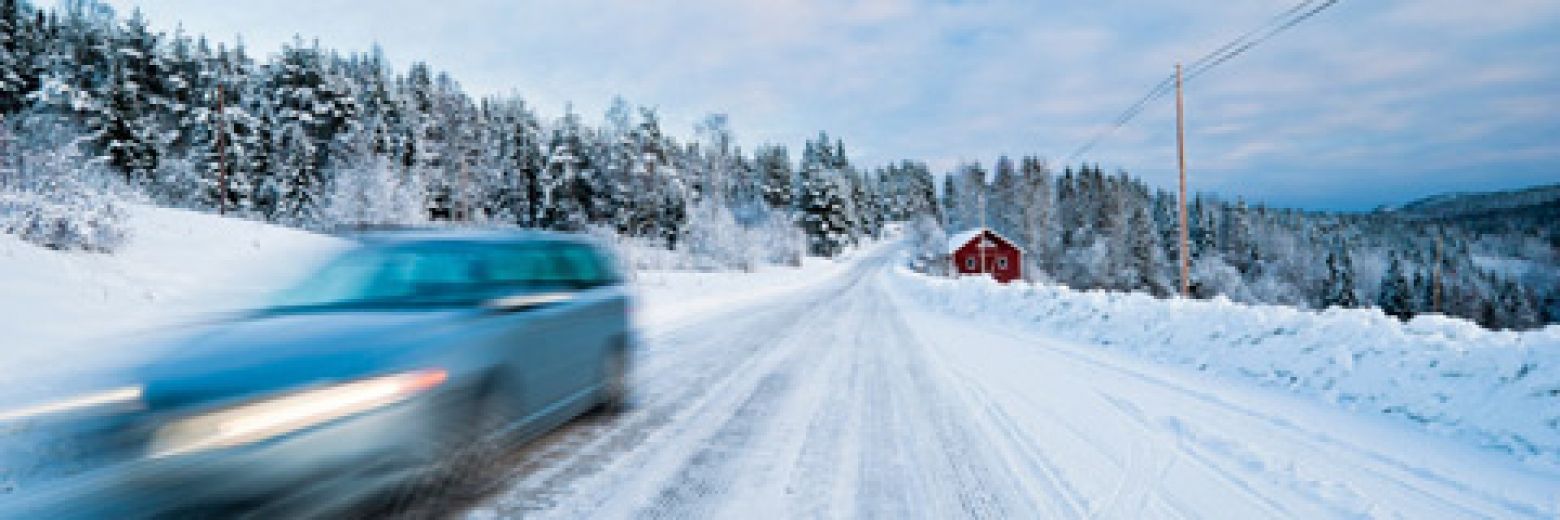Above all, you need to be prepared for road conditions much more severe than you would ever normally encounter at home. Driving abroad in winter can bring its challenges from ice, snow, freezing rain, fog, frost and strong winds. Winter sunshine too, can be problematic as drivers can easily be temporarily blinded by driving in the low sun
To give yourself complete peace of mind, make sure that you get European breakdown cover, whether you're planning on travelling to Europe all year round or just for a short trip.
Winter tyres
In Germany and many other continental countries, winter tyres are a legal requirement at certain times of the year or when conditions require them. Some countries allow visitors to drive on ‘normal’ tyres fitted with snow chains when road conditions or local signs dictate – but it is important to check rules before you depart on holiday.
Winter tyres are made from a different rubber compound so they don’t harden when it is cold, providing increased grip on the road and greater safety.
Motorists will benefit from using winter tyres whenever the temperature dips below seven degrees centigrade. They are suitable not just for snow-bound roads but are effective on slush, ice, frost and even wet roads, providing improved road handling and reduced stopping distances.
One winter tyre manufacturer claims a vehicle fitted with winter tyres will come to a standstill on a snow-covered (from a speed of 30mph) after 35 metres; however with ‘normal’ tyres, the braking distance required is a 43 metres – a further eight metres, or two car lengths.
It is important to know that winter tyres must be fitted in sets of four only. Fitting only one pair of snow tyres will adversely affect the balance and stability of the car.
READ: Guide on winter tyres - should you get some for your vehicle?
Snow chains
Snow chains are compulsory in some parts of Europe (depending on local conditions) although different countries have different snow chain laws, so it is important to check these before travelling abroad.
Specific countries where snow chains must be carried and used where signs dictate in mountainous regions include: France, Germany, Sweden, Switzerland, Norway, Italy, Austria and Andorra.
The use of snow chains is taken very seriously in relevant countries, with heavy fines potentially issued for failing to carry them. In addition, if your vehicle is involved in an incident where snow chains should have been used, it is automatically considered to be your fault.
To be on the safe side, you should always carry snow chains when visiting the countries outlined above and use them wherever and whenever necessary.
Only use snow chains when the road surface is covered in snow or ice. If you try to use chains on a road that has been cleared of snow and gritted, you risk damaging the road surface and your vehicle.
Snow chains can be difficult to fit and remove. Don’t just buy new snow chains, throw them in the boot and forget all about them until you are half way up a mountain somewhere in France. Make sure you practice fitting them at home when the weather is fine and dry – this will stand you in good stead for fitting them in adverse weather conditions on your holiday. Always follow the manufacturer’s guidelines and if any doubt, seek help from a qualified professional.

Instant cover available
• 24/7 rescue at the roadside
• Help to get home if your vehicle can't be fixed
• Five Star Defaqto rated cover
*Price is based on European comprehensive breakdown cover for a 14 day trip, in a vehicle up to 1 year old, travelling in zone 1.

Winter tyre requirements in Europe
Andorra
Winter tyres – RECOMMENDED
Note – from 1 November to 15 April and if roads are covered in snow, slush or ice outside these dates. Tyres must have a minimum tread depth of 4mm.
Snow chains – REQUIRED (should be carried and used as dictated by local signs or road conditions. Reduced speed limits may apply).
Austria
Winter tyres – MANDATORY
Note: Between 1 November and 15 April and at times outside these dates when there is snow, slush or ice on the roads. Minimum tread depth is 4mm.
Snow chains – REQUIRED (should be carried and used as dictated by local signs or road conditions. Reduced speed limits may apply).
France
Winter tyres – REQUIRED, drivers within 'snow zones' must have winter tyres and/or snow chains on their vehicle during the winter period from November 1 to March 31
Snow chains – REQUIRED, must be fitted to vehicles using snow-covered roads. (Should be carried and used as dictated by local signs or road conditions. Reduced speed limits may apply).
Germany
Winter tyres – COMPULSORY
Germany introduced regulations in 2010 requiring all passenger cars and motorbikes to be fitted with winter tyres or all season tyres on all axles in wintry conditions.
Snow chains – REQUIRED (should be carried and used as dictated by local signs or road conditions. Reduced speed limits may apply).
Italy
Winter tyres – RECOMMENDED - Between October and 15 April or, at other times if conditions dictate
Snow chains – REQUIRED - Between October and 15 April or, at other times if conditions dictate
Note: Some parts of Italy can introduce their own legislation making the use of winter tyres and snow chains compulsory.
Switzerland
Winter tyres – RECOMMENDED but not compulsory
*Note: However vehicles not equipped to travel through snow and ice and which impede traffic flow are liable to a fine.
Snow chains - REQUIRED (should be carried and used as dictated by local signs or road conditions. Reduced speed limits may apply).
Buy a European Driving Kit from £24.49
Don’t get stung with fines abroad for not having a European Driving Kit

Instant cover available
• 24/7 rescue at the roadside
• Help to get home if your vehicle can't be fixed
• Five Star Defaqto rated cover













